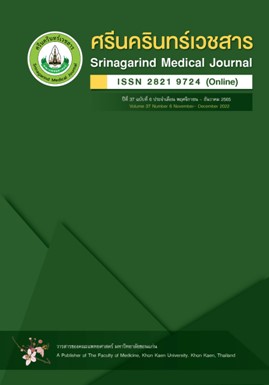การตรวจอัลตราซาวด์และความแม่นยำของการแปลผลการตรวจอัตราซาวด์ช่องท้องในผู้ป่วยที่ได้รับอุบัติเหตุโดยนักปฏิบัติการฉุกเฉินการเเพทย์
Focused Assessment with Sonography for Trauma Examinations Acquisition and Diagnostic Accuracy of Interpretation by Paramedics
Abstract
หลักการและวัตถุประสงค์: การตรวจอัลตราซาวด์ช่องท้องในผู้ป่วยที่ได้รับอุบัติเหตุ (FAST) ส่งผลให้การดูแลผู้ป่วยดีขึ้นในหลายประเทศ อย่างไรก็ตามข้อมูลความแม่นยำของการตรวจ FAST โดยนักปฏิบัติการฉุกเฉินการแพทย์ในประเทศกำลังพัฒนายังมีจำนวนจำกัด การศึกษานี้มีวัตถุประสงค์เพื่อศึกษาการตรวจ FAST และความแม่นยำของการแปลผลการตรวจ FAST โดยนักปฏิบัติการฉุกเฉินการเเพทย์
วิธีการศึกษา: เป็นการศึกษาไปข้างหน้าในผู้ป่วยอุบัติเหตุที่ได้รับการตรวจ FAST ในห้องฉุกเฉิน นักปฏิบัติการฉุกเฉินการเเพทย์ที่ปฏิบัติงาน ณ ห้องฉุกเฉินโรงพยาบาลขอนแก่นได้รับการเรียนการสอนภาคทฤษฎีเป็นเวลา 2 ชั่วโมงและการสอนภาคปฏิบัติเป็นเวลา 2 ชั่วโมงตามด้วยการสอนภาคทฤษฎีผ่านสื่อวิดีโอสำหรับทบทวนความรู้โดยแพทย์ฉุกเฉินผู้เชี่ยวชาญด้านอัลตราซาวด์ จากนั้นประเมินความแม่นยำในการแปลผล FAST โดยนักปฏิบัติการฉุกเฉินการเเพทย์ รวมถึงความสามารถในการตรวจอัลตราซาวด์ในผู้ป่วยจำลอง
ผลการศึกษา: นักปฏิบัติการฉุกเฉินการเเพทย์ทั้งหมด 10 รายเข้าร่วมการศึกษา นักปฏิบัติการฉุกเฉินการเเพทย์ทำการแปลผลอัลตราซาวด์จากผู้ป่วย 200 ราย ค่าความไว ค่าความจำเพาะ ค่าพยากรณ์ผลบวก และค่าพยากรณ์ผลลบในการแปลผล FAST เมื่อเปรียบเทียบกับผลการตรวจอัลตราซาวด์โดยแพทย์ฉุกเฉินผู้เชี่ยวชาญด้านอัลตราซาวด์เท่ากับร้อยละ 91.9 (95% CI, 78.1 - 98.3), 89.6 (95% CI, 83.8 - 93.8), 66.7 (95% CI, 55.8 - 76.0), และ 98.0 (95% CI, 94.3 - 99.3) ความแม่นยำเท่ากับร้อยละ 90.0 นักปฏิบัติการฉุกเฉินการเเพทย์ทุกรายสามารถทำการตรวจอัลตราซาวด์ร้อยละ 100
สรุป: นักปฏิบัติการฉุกเฉินการเเพทย์สามารถสามารถแปลผลอัลตราซาวด์ด้วยความแม่นยำที่สูงและสามารถทำการตรวจ FAST ในผู้ป่วยจำลองหลังได้รับการสอนเป็นเวลา 4 ชั่วโมง
คำสำคัญ: ความแม่นยำในการวินิจฉัย, นักปฏิบัติการฉุกเฉินการเเพทย์, การตรวจอัลตราซาวด์ช่องท้องในผู้ป่วยที่ได้รับอุบัติเหตุ, อัลตราซาวด์
Background and Objective: Prehospital Focused Assessment with Sonography in Trauma (FAST) training has resulted in improved trauma patient outcomes in multiple countries. Previous studies demonstrated good accuracy. However, data regarding the diagnostic performance among paramedics in developing countries is sparse. This study’s purpose was to examine the diagnostic accuracy of paramedic FAST exam interpretation and the success rate of image acquisition.
Materials and methods: This was a prospective observational study of trauma patients who received a FAST examination performed in the emergency department. Paramedics who worked at a tertiary emergency department in Khon Kaen hospital were included in this study. A 2-hour didactic lecture and 2-hour hands-on practice, followed by internet-based didactic session for review were provided by ultrasound-trained emergency physician. The diagnostic indices for FAST interpretation were calculated. Paramedics were also tested on image acquisition skills on a standardized patient using a standardized assessment tool.
Results: In total, 10 paramedics voluntarily participated and underwent FAST training. FAST exams from 200 patients performed in the emergency department were evaluated by paramedics. The paramedics were mostly ultrasound-naïve. The sensitivity, specificity, positive predictive value, and negative predictive value for image interpretation by paramedics compared to FAST results by ultrasound-trained emergency physician were 91.9% (95% CI, 78.1 - 98.3), 89.6% (95% CI, 83.8 - 93.8), 66.7% (95% CI, 55.8 - 76.0), and 98.0% (95% CI, 94.3 - 99.3), respectively. The overall accuracy was 90.0%. All of the paramedics were able to successfully complete 100% of the views of the FAST and achieved a practical standard considered by the ultrasound-trained emergency physician.
Conclusions: This study determined that paramedics were able to interpret FAST exams with a high degree of accuracy and perform FAST in a simulated environment following a four-hour training course.
Keywords: diagnostic accuracy, paramedic, FAST, ultrasonography


